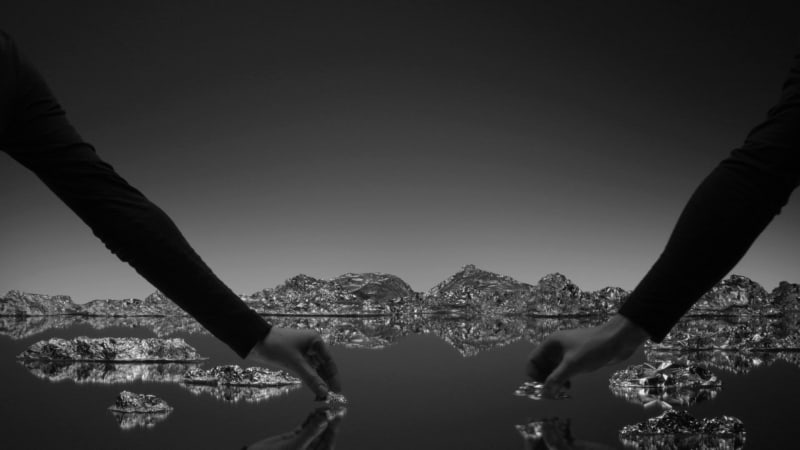BY LOUIS BURY
Two Caucasian hands — one male, one female, the latter wearing a pearl bracelet — reach into a film frame to assemble, piece-by-piece, a diorama-scale cityscape. In the foreground, they situate a rustic house on a pier underneath a bridge; in the background are silhouettes of skyscrapers lit up at night. A breeze momentarily sends gentle ripples and puffs of mist along the river before the male hand reappears to remove the bridge. The skyscrapers fade from view and dawn yellows the horizon.
A foggy, reed-covered swampland fades in, becoming the house’s new background for a moment. Then both hands return to disassemble the house as the swampland fades out, leaving a thin puddle of water onscreen. With unhurried swoops, the hands start to drain the puddle, first with teacups, then with sponges — jump cuts accelerating the process — before a footbridge fades into view over the now-dry waterbed. The two hands clasp in the center of the screen. The man’s other hand enters next; holding a scissor he delicately snips off the woman’s bracelet, its pearls tumbling onto the bridge to become the first in a luminescent carpet of pearls that will soon cover the bridge’s surface.
The film is Hans Op de Beeck’s Staging Silence (3), the eponymous trilogy’s ravishing final installment, on view at Boesky East. It proceeds in this vein, shapeshifting from one landscape to the next over 45 minutes, accompanied by a minimalist classical score by UK musician Scanner. Each scene has its own droll, tactile beauty — for instance, one scene features a cemetery built out of bonbons and broccoli — but the whimsical fantasia of the film’s set changes constitutes its emotional and intellectual core. In it, time inches along, uneventful, then undergoes periods of rapid and startling change.
In the way they constantly make and unmake the world onscreen, the disembodied hands emphasize humankind’s role in environmental changes. This anthropogenic seesaw ride receives its starkest dramatization in a sequence where the hands sculpt an elaborate medieval fortification out of sand, then tilt watering cans above it as the increasingly waterlogged structure droops away like melting wax. The fort’s disintegration — like so much in the film, a parable of climate change, as well as of the simple passage of time — calls to mind the “lone and level sands” that remain at the end of Percy Shelley’s sonnet “Ozymandias”: a cosmic, dust-to-dust reminder of human vanity’s folly. But the film’s infectious and understated levity sidesteps parable’s moralistic heavy-handedness. The fort’s soggy ruins will soon become a field of sunflowers; the flowers will be burned down with crème brûlée torches; their charred remains will transform into a tropical archipelago; and on and on, forming a tragicomic two-step in which an antic beauty keeps finding ways to rise from our equally antic ashes.

